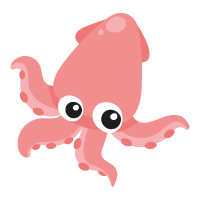The newborn vision is not as clear as in adult.
The development of vision will become gradually clearer by the age of 4 to 5 years.
The visual behaviors of children of each age range can be described as follows.
Nearsightedness (Myopia) is caused by:
The eyeball is longer than focal distance caused from heredity,
some types of eye diseases, or the results from childhood behavior in which their
eyes have been used to see or look at objects within near distance for and extended
amount of time.
The disadvantage of myopia
is that the children cannot see clearly. The clarity level of vision depends on the severity of myopia.
If they have less severe level of myopia, they simply cannot see clearly only when the seeing object is further away
such as looking at the board. Thus, when the object is seen in near distance (such as reading book),
they can see perfectly. If they have high level of myopia, then objects cannot be clearly seen both near and far.
Amblyopia (lazy eye) can affect not only on one but on both eyes. This is the result of
inadequate development of vision in the brain of the child. Blurry vision over an extended amount of time
can cause visual impairment and lead to implications and successful treatment when reaching adulthood.
Children with severe myopia need immediate treatment. Strabismus will may occur when they are unable to
see clearly for long time. Furthermore, severe myopia will cause thinner retina of the patients to have
higher risks for retinal diseases more than normal people, for example, retinal tears,
retinal detachment and macular abnormality, etc.
Suspicious Symptoms of Myopia
Apart from blurred vision, slanted eyes, tilt the neck to see, watching T.V. near the screen and
bend down to read books closely are also the signs suggested that the children cannot see clearly.
However, the children who have high nearsightedness in one eye side do not usually show any abnormalities.
Preparation before eye examination
In the eye examination, the ophthalmologist may need to use mydriatic eye drops in order to
loosen the gaze of children’s eyes. This will lead to blurred vision (amblyopia), and the eyes to be sensitive
to the light for 2 days after the examination. For this reason, parents should bring the children to the eye
examination during the time when there are no important exams or outdoor activities within that time period.
For the children within the age of 2 ½ to 5 years, who cannot read numbers well, it is recommended for children
to learn certain images in order to recognize those used in the examination room.
How to treat nearsightedness (Myopia)?
The treatment of nearsightedness (Myopia) is based on its severity.
Children with less severe level of myopia may not require any treatment, but should be
continuously monitored. Children affected with high level of myopia, however,
are recommended to wear corrective eye glasses. Wearing contact lenses or undergoing
Lasik surgery are not recommended to young children, but more popular amongst adults.
The nature of myopia
Nearsightedness or myopia in children increases continuously because the eye grows naturally on average at 0.5 diopter per year and reduced growth in adults.
Apart from it being genetically inherited, present study has suggested that the myopia of
some children may have increased very quickly mainly from their behavior of looking at near distance for
long time such as reading book, looking at tablet or mobile phone, playing computer,
drawing and making model, etc.
Parents should consider reducing those kinds of activities unnecessary for their children.
For example, reduce playing games or watching cartoons on mobile phones, tablets or computer; reducing reading cartoons
or fiction books, and increasing more activities with outdoor activities involving interaction with objects in
various distances. Furthermore, studies have proven that exposure to natural light is an effective method in
reducing the consequences of myopia.
If the effects of myopia is persistent after taking all advice and recommendation in account,
the ophthalmologist may consider an initial treatment by applying eye drops in order to reduce the conditions
of myopia. The types of eye drops and treatment options depends on each patient. The patient should consult
the ophthalmologist for a proper treatment.
" When abnormal symptoms found in children’s eyes:
The symptoms such as ptosis (eyelid dropping), strabismus, eyes shivering, tears flow,
red eyes or other abnormalities should be concerned by parents once they occurred to your children.
Children should be brought to see the ophthalmologist immediately.
Depending on the severity, if left untreated, chances of vision loss may occur."
For children without any ocular symptoms, parents do not need to see an ophthalmologist during the infantry of their child.
However, children should visit the ophthalmologist periodically by age as follows.
-
First time when children are 6 months old
The ophthalmologist will examine whether the child uses both eyes equally,
and also check whether they have ocular abnormalities, strabismus, myopia and
presbyopia or not.
-
Second time when children are 2 1/2 - 3 years old
The ophthalmologist will be able to measure standard value of the baby's vision
for the first time. If the child has eye disorders, they will be treated promptly.
Blindness can result from two -
Third time when children are 6-7 years old
This age range is the age at which children begin to attend elementary school.
Children should be taken to have their eyesight measured whether they need to
wear glasses or not.
-
Next time: At least once a year
To check eyesight and general eye health


